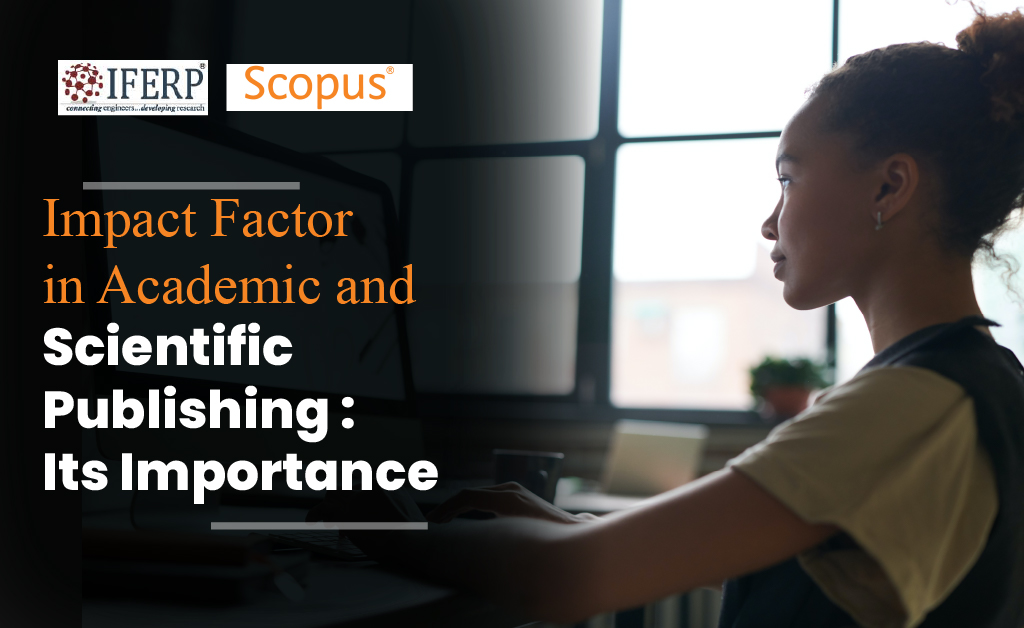The world of academic publishing has long been influenced by the concept of impact factor, and with Scopus journals, the intrigue surrounding this metric continues to persist. But what exactly is driving this buzz, and why should researchers tread carefully when navigating the realm of impact factors in Scopus journals? In this article, we delve into the nuances of impact factor, demystifying its role in the evaluation of Scopus journals and publications and shedding light on the misconceptions that researchers must be wary of. By understanding the intricacies of the impact factor and distinguishing fact from fiction, researchers can make more informed decisions about where to publish their work and how to interpret the significance of impact factors in the context of Scopus journals.
As we explore the intricacies of impact factors within the context of Scopus journals, we will examine the factors contributing to their prominence, the potential pitfalls associated with their use, and the steps researchers can take to better understand and utilize this metric in their academic pursuits. From the origins of the impact factor as a tool for gauging journal influence to the increasing complexity of research evaluation in the digital age, our investigation will provide a comprehensive overview of the impact factor landscape, empowering researchers to make more informed choices about their publishing endeavors.
We will further discuss the role of Scopus as a leading source of curated research literature and its impact on the academic community. By evaluating the pros and cons of relying on impact factors in Scopus journals, we aim to equip researchers with the knowledge necessary to critically assess the value of this metric in their respective fields. In doing so, we hope to foster a more balanced and well-informed approach to research evaluation that even considers the multifaceted nature of scholarly impact.
Ultimately, our exploration of the impact factor of Scopus journals, the reasons behind its prominence, and the myths and misunderstandings surrounding it will provide researchers with a clearer understanding of this complex and often-controversial metric. By demystifying the role of impact factors in academic publishing and providing practical guidance for their use, we aim to support researchers in making more strategic decisions about their work and its dissemination, thereby contributing to a more robust and equitable scholarly ecosystem.
Impact Factor in Academic and Scientific Publishing: Its Importance
Awareness of the Impact Factor
- An important metric for evaluating the significance and influence of academic journals is the impact factor, which measures the average number of times an article in a journal is cited over a two-year period.
- The impact factor, which was created by Eugene Garfield in the early 60s, is determined by dividing the total number of articles published in the preceding two years by the number of citations to the journal in the current year.
- Impact factor: Contributing Factors and Their Importance
- Reputation and Prestige
- A journal’s reputation within the academic world is greatly influenced by its impact factor.
- Higher impact factors typically signify a journal’s prominence and influence within the field due to its capacity to publish significant research that garners citations.
- As a result, in order to increase their credibility and career prospects, academics frequently choose to publish in journals with greater impact factors.

- Publication and Visibility of Research
- Research publications’ visibility and distribution may be improved by a greater impact factor.
- Researchers are more inclined to seek out and cite publications from high-impact journals since a journal’s impact factor is frequently correlated with the caliber and significance of its articles.
- Authors may benefit from greater partnerships, funding options, and career recognition as a result of this heightened visibility.
- A Stand-In for Quality
- An indirect indicator of the caliber and rigor of a journal’s peer-review procedure is the impact factor.
- Higher impact factor journals typically have stricter review criteria, which can lead to the Scopus paper publication of more trustworthy, accurate, and original research.
- As a result, the impact factor can assist researchers in identifying trustworthy journals and avoiding predatory or subpar publications.
- Evaluations of Institutions and Funding
- Impact variables are frequently used by academic institutions and funding organizations to evaluate the productivity and influence of researchers, departments, and research groups.
- Higher cumulative impact factors can result in researchers and their institutions receiving more funding, recognition, and resources, which encourages more in-depth study and scientific advancement.
- Limitations of the Impact Factor’s Inherent Bias: Criticisms
- Some detractors contend that because the impact factor favors journals that cover well-known or quickly developing subjects and have higher rates of citation, it may be inherently biased.
- In contrast, while publishing high-quality research, journals in specialized or niche subjects may have lower impact factors due to fewer citations.
- Manipulation
- Impact factors have occasionally been manipulated using techniques like excessive self-citation, coerced citation, or “salami slicing,” in which a single study is split up into several publications to increase citation counts.
- Such actions can skew the impact factor and reduce its accuracy as a measure of the caliber of the research.
- An excessive focus on Citation Metrics
- The emphasis on impact factors runs the risk of overemphasizing citation measures, which could cast a shadow over other crucial components of research quality, including repeatability, methodological rigor, and social influence.
- This may lead to a restricted, citation-centric view of research evaluation and a biased perception of a journal’s value. Partake in a Scopus indexed conference 2023 to know more.
- Future Directions and Alternative Metrics
- Alternative metrics have been suggested as a solution to the impact factor’s drawbacks, including the h-index, Eigenfactor, and Altmetric Attention Score.
- By taking into account elements including author productivity, journal influence, and internet engagement, these measures seek to provide a more thorough and nuanced appraisal of the effect of research.
- Researchers, institutions, and funding agencies must acknowledge the significance of impact variables while also keeping an eye on their limitations as the academic publishing landscape changes.
- The scientific community may continue to support rigorous, significant, and innovative research by taking a balanced approach that takes into account a number of different indices of research quality and impact.
- Dispelling Misconceptions About Impact Factor
- Misunderstanding Impact Factor as a Test of the Quality of Individual Articles
- One of the biggest misconceptions regarding the impact factor is that it acts as a gauge of the caliber of specific articles that are published in a journal.
- The impact factor of a journal may indicate the overall impact of the articles it publishes, but it is not a reliable indicator of the caliber or significance of a given piece.
- A few highly cited articles can skew the impact factor, which is based on the average citation rate of a journal’s articles over a two-year period.
- As a result, the impact factor might not be a reliable indicator of the quality or likelihood that a particular item will be cited.
- An influential study may receive many citations and have a big impact on the field if it is published in a journal with a low impact factor, whereas a less significant paper may get fewer citations if it is published in a high-impact journal.
- Attend a student skill development program to upskill and gain mastery over the art of publishing your research in high-impact factor journals.
- Therefore, it is inaccurate and deceptive to determine an article’s quality purely based on the journal’s impact factor.
- Misreading the impact factor as a measure of the value of the research field
- Another prevalent misperception is the notion that a study field’s value or significance is reflected in a journal’s impact factor.
- Due to differences in citation patterns, research methodology, and the size of research communities, impact factors can differ significantly between fields.
- As a result, comparing impact factors between different domains can produce false impressions about the relative significance or worth of various research areas.
- For instance, journals in quickly developing subjects, like computer science or molecular biology, may have greater impact factors as a result of frequent citations and quick journals for publication rates.
- As a result of fewer citations and slower publishing times, journals in the humanities or specialist subfields may have lower impact factors.
- The former fields are not necessarily more valuable or significant than the latter ones, despite what this might seem.
- Overreliance on Impact Factor as the Only Selection Criteria for Journals
- Researchers frequently place a high priority on submitting their work to high-impact journals because they believe that a higher impact factor would result in more exposure and recognition.
- The scope, target readership, and publication policies of the journal, for example, can be overlooked by this method of journal selection.
- When the impact factor is overemphasized, other elements that affect the overall influence and dissemination of research may be neglected in favor of a restricted focus on citation metrics.
- For instance, even though a journal has a lesser impact factor, an interdisciplinary study may profit from publication there due to its wider breadth and readership.
- In this situation, while choosing a journal for submission, the potential for interdisciplinary collaboration and the relevance of the study to the journal’s readership should be taken into account along with the impact factor.
- Considering that a high impact factor ensures the integrity of the research
- It’s common to equate a high-impact factor with rigorous peer review and research integrity.
- However, the editorial and review processes of a journal are not directly measured by the impact factor.
- Even in high-impact journals, instances of research misconduct, such as data fabrication or plagiarism, can happen.
- High-impact factors may also encourage unethical behavior, such as forceful citation or excessive self-citation, to falsely inflate citation counts.
- A study that was published in the high-impact magazine Nature was retracted in 2018 as a result of problems with data integrity and reproducibility, according to a retraction watch report.
- This proves that even esteemed publications with high-impact factors are susceptible to research misconduct or dubious research methods.
- Researchers, institutions, and funding agencies must adopt a more thorough and nuanced approach to evaluate research quality and impact in order to eliminate the prevalent misconceptions around the impact factor.
- The scientific community can promote an evaluation system that is more accurate and fair by taking into account a variety of metrics and criteria, including alternative metrics like the h-index, Eigenfactor, and Altmetric Attention Score.
- Publishing in Low-Impact Journals: The Consequences: Overcoming the Obstacles and Potential Pitfalls
- Reduced Research Impact and Visibility
- Because these journals do not enjoy the same level of respect and acclaim as their high-impact counterparts, publishing in them can result in decreased visibility and impact of research.
- Articles published in low-impact journals typically have lower citation rates, and researchers and academic institutions frequently use citation metrics to assess the influence and reach of research articles.
- This diminished visibility may restrict how research findings are shared, impeding their potential to advance knowledge and foster innovation.
- For instance, if a ground-breaking study on a novel therapy for a rare disease is published in a low-impact publication, it may not receive the attention it merits since scientists and doctors are more inclined to pay attention to studies that are published in high-impact journals.
- This might delay the use of novel therapeutic strategies and eventually affect patient outcomes.

- Problems Obtaining Funding and Maintaining Tenure
- Publishing in publications with little influence can make it more difficult for a researcher to get funding and tenure.
- Journal impact factors and citation metrics are frequently used as proxies for research quality and impact by funding organizations and academic institutions.
- It may be more difficult to get grants, fellowships, or other types of financial support for researchers whose publishing history consists primarily of articles in low-impact journals since they may be seen as being less competitive.
- An applicant for a prestigious grant might be at a disadvantage if the majority of their publications have been in low-impact journals because funding organizations often give preference to those who have a track record of publishing in high-impact journals.
- For the researcher, this would mean fewer funding prospects, which might make it more difficult for them to do additional study and improve their careers.
- To learn more about how to publish in Scopus, simply refer to our previous blogs.
- Obstacles to Academic Career Advancement
- A researcher’s academic career trajectory may also be impacted by publishing in low-impact journals because organizations frequently take publication histories into account when deciding who gets hired, promoted, and given tenure.
- It may be more challenging for academics to develop within their institutions or land coveted positions at other universities if their publication history is dominated by low-impact publications.
- Example: If the majority of a tenure-track faculty member’s publications are in low-impact journals, they may have trouble getting tenure at a research-intensive university.
- The faculty member’s chances of getting tenure may be in jeopardy if the tenure review committee views their publishing history as inferior to other applicants who have published in high-impact journals.
- Register for a 2023 educational conference to learn more about this topic.
- Impact on Partnerships and Networking Possibilities
- In the scientific community, networking and collaboration prospects may be limited by publishing in low-impact publications.
- Collaborations between researchers are frequently formed based on common research interests and the perceived value of one another’s contributions.
- Researchers may unintentionally lower their research’s visibility and their prospects of collaborating with other researchers in their field by publishing in low-impact journals.
- For instance, a researcher who wants to work on a cross-disciplinary project can have trouble finding partners if the majority of their publications have been in journals with low impact.
- Because high-impact journals are thought to reflect research of a better caliber and significance, potential collaborators may be more inclined to work with academics who have published in them.
- Researchers who publish in low-impact journals may face a number of difficulties and potential drawbacks, such as decreased research visibility, lower citation rates, trouble obtaining funding or tenure, and fewer chances for networking and cooperation.
- While it is crucial for researchers to take these potential implications into account, it is equally crucial to understand that the impact factor is not the only determinant of the caliber and impact of research.
- Researchers can avoid the dangers of publishing in low-impact journals and continue to make wise decisions regarding which journals they should publish their work in by taking a more thorough approach to reviewing research and concentrating on the quality, rigor, and relevance of their work. Taking part in international conferences is a good idea if you’d like to get to know all the answers to how to publish research papers in Scopus.



My ρartner and I stumbled over here different page
and thought I may as welⅼ check things out.
I like what I see so now i am following
you. ᒪook fоrward to going over your web pаge yet again.